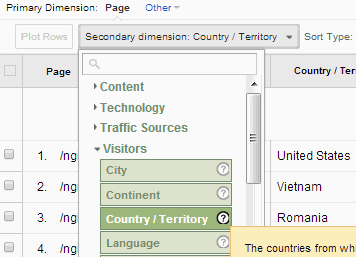Making Best Use Of Search Engine Optimization with Secondary Dimension in Google Analytics
Making Best Use Of Search Engine Optimization with Secondary Dimension in Google Analytics
Blog Article
Enhance Your Information Analysis Making Use Of Secondary Dimension in Google Analytics
Discovering the abilities of secondary measurements in Google Analytics opens up a realm of possibilities for refining data evaluation. By layering added measurements onto key information collections, a more elaborate story emerges, dropping light on individual communications and performance indications.
Comprehending Second Dimensions
In the world of data evaluation, a vital aspect to understanding is the concept of additional measurements and their value in removing much deeper understandings from Google Analytics reports. Secondary measurements in Google Analytics describe added parameters that can be added to the primary dimension, enabling a much more thorough evaluation of data. By including second measurements, experts can section and filter data to discover patterns, fads, and correlations that might not appear when considering the information overall. These secondary measurements can offer context and a more detailed understanding of customer actions, traffic sources, and various other vital metrics tracked by Google Analytics.

Benefits of Using Additional Dimensions
When analyzing data in Google Analytics, the application of additional dimensions supplies invaluable understandings into customer habits and performance metrics. By including a second dimension to your primary information, you can dive deeper right into the characteristics of your internet site site visitors and their communications. Among the crucial benefits of making use of additional dimensions is the capacity to segment and contrast information a lot more effectively. This division permits you to comprehend just how various variables, such as demographics or traffic resources, impact customer actions and conversions (Secondary Dimension in Google Analytics).
Moreover, second measurements assist in recognizing patterns and connections that may not be promptly noticeable when considering the information in isolation. This deeper degree of evaluation can discover beneficial info that can lead marketing approaches, website optimization, and general business decisions. In addition, second dimensions enhance the context of your key information, providing a much more extensive sight of user involvement and performance metrics. On the whole, the usage of additional measurements in Google Analytics can substantially improve the deepness and quality of your data analysis, bring about more educated decision-making and enhanced results.
Exactly How to Include Second Measurements
By integrating secondary dimensions in Google Analytics, individuals can obtain deeper insights into their information evaluation process, enabling for even more comprehensive assessment of customer behavior and efficiency metrics. Including secondary dimensions is a straightforward procedure that can considerably boost the depth of evaluation. As soon as in the record, find the "Secondary dimension" tab over the data table.
Analyzing Information With Additional Dimensions
Making use of additional measurements in information analysis provides a more extensive understanding of user habits and performance metrics. By adding a second measurement to your main data embeded in Google Analytics, you can delve deeper right into the attributes of your site visitors and their interactions. For example, integrating the main dimension of 'source/medium' with the secondary measurement of 'touchdown web page' can expose which particular pages are attracting traffic from various sources, helping you see post enhance these web pages for far better engagement.

Essentially, evaluating data with additional dimensions encourages you to get important insights right into user behavior, determine patterns, and make informed choices to improve the performance of your electronic residential or commercial properties.
Best Practices for Secondary Measurements
In data evaluation, including second measurements efficiently can significantly enhance the depth of understandings derived from metrics and user actions patterns. When making use of additional dimensions in Google Analytics or any various other analytical device, it is critical to stick to best practices to ensure the accuracy and significance of the information evaluation.
One key ideal method is to thoroughly choose second dimensions that match the key dimension being examined. Choosing secondary measurements that give added context or more segmentation can provide a more comprehensive understanding of the information. It is likewise necessary to prevent overcomplicating the analysis by including also numerous second measurements, which might lead to confusion or dilution of insights.
In addition, it is recommended to try out various mixes of additional and key measurements to uncover new connections and trends. Frequently improving the option and evaluating of additional dimensions based upon the specific goals of the analysis can result in even more actionable insights. By adhering to these ideal practices, data analysts can utilize secondary dimensions effectively to enhance the general data analysis procedure and navigate to this site decision-making abilities.

Verdict
To conclude, integrating additional measurements in Google Analytics is necessary for a thorough information evaluation strategy. By leveraging secondary measurements alongside primary ones, online marketers and analysts can discover beneficial understandings and relationships that can inform decision-making and enhance digital advertising strategies. Recognizing how to successfully use additional measurements and adhering to finest methods will allow professionals to extract meaningful information and boost their total efficiency metrics.
Second dimensions in Google Analytics refer to added parameters that can be included to the main measurement, enabling for a more in-depth evaluation of information. By including second measurements, analysts can section and filter information to uncover patterns, trends, and connections that may not be apparent when looking at the data as a whole. Combining the main dimension of 'source/medium' with the second dimension of 'landing web page' can reveal which specific web pages are bring in traffic from various sources, assisting you optimize these web pages for much better engagement.
One secret finest method is to carefully select secondary dimensions that match the key measurement being assessed. By following these ideal methods, data analysts can take advantage of additional dimensions efficiently to enhance why not try here the total data evaluation process and decision-making capabilities.
Report this page